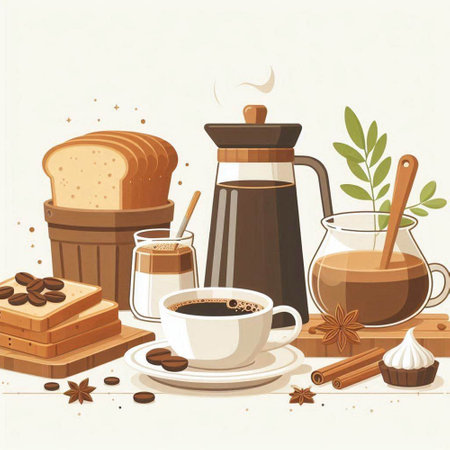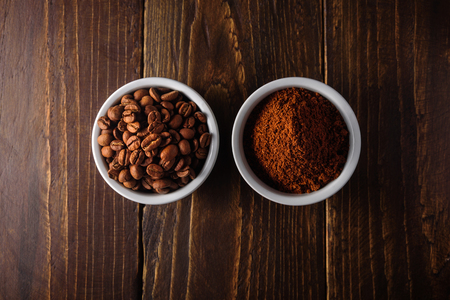Introduction – A New Wave in Your Cup
Step into any bustling coffee shop from Brooklyn to San Francisco, and youll notice a quiet revolution swirling in your cup. Where once whole milk reigned supreme, now oat, almond, soy, and even macadamia milks are front and center on the menu. The rise of non-dairy milks in American coffee culture is more than just a trend—it’s a reflection of shifting values, health priorities, and an expanding curiosity for global flavors. This movement isn’t just about what we pour into our lattes; it’s about who we are as consumers, how we’re influenced by wellness conversations, environmental concerns, and the vibrant tapestry of multicultural influences shaping our cities. As plant-based options blend seamlessly into everyday rituals, they signal broader cultural shifts—a move toward personalization, inclusivity, and a craving for new taste experiences that echo far beyond the coffee counter.
2. A Brief History of Non-Dairy Milks in the U.S.
To truly understand the modern coffee scene’s obsession with non-dairy milks, it’s essential to explore how plant-based milks journeyed from obscure health food aisles to café counters across America. The story starts back in the early twentieth century when soy milk was introduced in Asian-American communities and natural food stores. For decades, these alternatives were mostly relegated to specialty shops, seen as an option for those with lactose intolerance or strict dietary needs rather than a choice for mainstream coffee drinkers. The 1990s saw a surge in vegetarian and vegan movements alongside increased awareness of food allergies, which gradually brought soy and rice milks into broader public consciousness.
By the early 2000s, almond milk began making waves as a flavorful, lighter-tasting alternative—its nutty profile pairing well with espresso drinks. Coffeehouses, especially independent cafés on the West Coast, were quick to catch on, offering these options to cater to evolving customer preferences. As more consumers sought health-conscious or environmentally friendly lifestyles, cafés became laboratories of experimentation: oat milk, coconut milk, and even hemp milk made appearances on menus, each bringing unique textures and flavors that resonated with adventurous palates.
Today’s landscape is a far cry from the limited choices of decades past. Here’s a snapshot of how non-dairy milks have evolved within U.S. coffee culture:
| Decade | Popular Non-Dairy Milks | Cultural Context & Coffee Impact |
|---|---|---|
| 1970s–1980s | Soy Milk | Health food stores; niche among vegetarians and lactose-intolerant communities; rarely seen in cafés |
| 1990s | Soy, Rice Milk | Growth of vegetarianism/veganism; first appearances in select urban coffeehouses |
| 2000s | Soy, Rice, Almond Milk | Mainstream acceptance grows; almond milk’s popularity surges; coffee chains begin offering alternatives |
| 2010s–Present | Oat, Coconut, Cashew, Hemp, Pea Protein Milks (and more) | Diverse options become standard; barista-friendly formulations emerge; non-dairy lattes go viral on social media; sustainability concerns drive further innovation |
This evolution reflects not only changing dietary trends but also a profound cultural shift—one where American coffee culture embraces diversity in flavor and values-driven consumption as much as it does tradition and taste.

3. Flavor Journeys: How Non-Dairy Milks Are Shaping Coffee Experience
Step into any American café and you’ll find a menu that reads like an invitation to a flavor adventure. Oat, almond, soy, coconut, and even macadamia milks are rewriting the rules of coffee culture, each bringing its own character to the cup. Oat milk, with its creamy texture and subtle sweetness, has become a favorite for those seeking a latte that feels indulgent but light. It complements espresso’s natural caramel notes without overpowering the roast. Almond milk delivers a nutty undertone and a slightly thinner mouthfeel; it’s perfect for those who appreciate a crisp contrast in their iced coffees or cold brews. Soy milk, one of the earliest non-dairy options, offers a balanced creaminess and neutral profile—its protein content makes it an excellent frother, holding up to intricate latte art.
Baristas across the U.S. have turned these milks into creative tools, experimenting with blends and ratios to achieve the ideal balance between coffee and milk. Some shops craft signature drinks by mixing oat and coconut milk for added depth, while others infuse house-made nut milks with vanilla or cinnamon for a twist on tradition. Consumers have become part of this flavor exploration too—ordering custom combos or chasing after seasonal non-dairy offerings as if hunting down limited-edition sneakers.
This sensory revolution isn’t just about taste; it’s about how texture, aroma, and visual appeal come together in every sip. The rise of microfoam from oat or soy milks means that vegan cappuccinos can be just as velvety as their dairy counterparts. Meanwhile, almond milk’s translucent pour invites experimentation with layered drinks and vibrant coffee cocktails. In cities like Portland, Austin, and Brooklyn, where coffee is more than just fuel—it’s an identity—these non-dairy milks are redefining what it means to enjoy a cup of joe. Every pour is both a celebration of diversity and a nod to America’s ever-evolving palate.
4. Cultural Reflections: Identity, Inclusion, and Wellness
In today’s American coffee scene, non-dairy milks have evolved far beyond the realm of dietary necessity—they’re now deeply interwoven with cultural identity, values, and social inclusion. For many, ordering an oat milk latte or an almond milk cappuccino is not just about personal health or avoiding lactose. It’s a statement that signals belonging to a community conscious of sustainability, wellness, and inclusivity. Coffee shops across cities like Portland, Austin, and Los Angeles showcase menus where non-dairy options are front and center, reflecting their neighborhoods’ diverse values.
The New Language of Belonging in Cafés
Coffeehouses have long served as gathering spaces for creative minds and culture seekers. Today, offering a wide variety of non-dairy milks has become a marker of a progressive and welcoming establishment. Whether it’s catering to vegans, those with allergies, or individuals seeking environmentally friendly choices, the presence of alternative milks helps make everyone feel seen and valued. The simple question—“What kind of milk would you like?”—has become a subtle gesture of respect toward individual identities and needs.
More Than Just Taste: Values Behind Every Pour
The choice between soy, almond, oat, or coconut milk often goes beyond flavor preference. Each option carries its own cultural resonance and environmental footprint. For example:
| Milk Type | Cultural Associations | Sustainability Impact | Health & Wellness Appeal |
|---|---|---|---|
| Soy Milk | Long history in Asian-American communities; early staple for vegans | Moderate water use; lower emissions than dairy | High protein; cholesterol-free |
| Almond Milk | Linked to Californian agriculture; popular with plant-based eaters | High water consumption; low carbon footprint | Low calorie; vitamin E-rich |
| Oat Milk | Rising star in hip urban cafés; Scandinavian roots embraced by US baristas | Low water usage; highly sustainable crop | Creamy texture; fiber content; allergen-friendly |
| Coconut Milk | Ties to tropical cuisines & Latinx/Asian-American cultures | Sustainable but often shipped long distances | Lactose-free; rich taste for specialty drinks |
Wellness Meets Cultural Identity
The popularity of non-dairy milks mirrors shifting attitudes toward holistic health and self-expression. Choosing oat milk might signal eco-consciousness, while coconut milk can be an homage to one’s heritage or culinary traditions. In this way, every cup becomes a canvas for both personal wellness goals and cultural pride.
An Inclusive Urban Ritual
Coffee rituals increasingly reflect America’s multicultural tapestry. As baristas learn to steam oat milk just right or create foam art with soy milk, they’re also participating in a broader dialogue about diversity and acceptance. Non-dairy milks are no longer niche—they’ve become symbols of openness and unity in the everyday act of sharing coffee.
5. Mainstream Movement: Coffee Chains and the Shift to Plant-Based
Walk into any major coffee shop across the U.S. these days, and it’s clear: non-dairy milks are no longer a fringe option—they’re front and center, as familiar as drip coffee or classic espresso. Giants like Starbucks, Dunkin’, and Peet’s have not only added almond, oat, soy, and coconut milk to their menus, but also woven plant-based choices into seasonal drinks and everyday staples. This shift isn’t just about keeping up with trends; it’s about meeting changing American tastes and values. Starbucks was one of the first national brands to roll out soy milk back in the early 2000s, but the real turning point came when oat milk hit their stores in 2021—sparking social media buzz and even temporary shortages as demand spiked. Dunkin’ quickly followed suit, adding oat and almond options and launching campaigns that highlight plant-based pairings with their signature donuts. These menu changes go hand-in-hand with marketing that leans into sustainability, wellness, and inclusivity—think Instagram-worthy oat milk lattes or ads celebrating lactose-free lifestyles. The result? Non-dairy milks have reshaped how Americans think about their daily cup, making plant-based choices both aspirational and accessible. By normalizing these options nationwide, coffee chains are steering consumer habits on a grand scale—turning what was once a niche preference into an everyday ritual from coast to coast.
Urban Cafés and Local Stories
Step into any independent café from Brooklyn to Seattle, and you’ll find more than just a cup of coffee—you’ll encounter a living snapshot of how non-dairy milks are weaving themselves into the fabric of American urban culture. These coffee shops are not only flavor laboratories but also vibrant community hubs that reflect their neighborhood’s values, tastes, and quirks.
Innovation in Every Cup
In Portland’s Pearl District, baristas at family-owned cafés experiment with house-made oat milk blends, infusing lattes with local honey or a pinch of sea salt for an unexpected twist. Down in Austin, you might spot a chalkboard menu spotlighting Texas pecan milk, created to celebrate the region’s agricultural roots. These small-batch innovations aren’t just about taste—they’re about identity, inviting locals to sip something uniquely theirs.
Customer Engagement: The Heartbeat of Community
Across Los Angeles, indie coffeehouses host non-dairy “milk flights,” encouraging regulars to compare almond, macadamia, and soy alongside single-origin espresso shots. In Chicago’s Pilsen neighborhood, shop owners invite customers to monthly “Milk & Mingle” nights, where patrons can vote on new plant-based options and share their own stories about why they’ve made the switch. It’s a two-way conversation—one where customers feel heard and empowered.
Neighborhood Culture Shapes the Trend
Each city stamps its personality on non-dairy coffee culture. San Francisco cafés often highlight sustainability by partnering with local creameries making cashew or hemp milk in small eco-conscious batches. Meanwhile, Miami’s Little Havana integrates coconut milk cortaditos as a nod to Cuban heritage and tropical flavors. These localized spins remind us that non-dairy trends aren’t just imported—they’re shaped by the people who call each place home.
From coast to coast, these urban cafés demonstrate that the journey of non-dairy milks is as much about community storytelling and cultural pride as it is about dietary choice. In every frothy pour and innovative recipe lies a piece of the city itself—proof that America’s love affair with coffee continues to evolve in wonderfully local ways.
7. Looking Ahead: The Future of Coffee and Non-Dairy Innovation
As American coffee culture continues to evolve, the role of non-dairy milks is poised to become even more influential in shaping both what we drink and how we gather. The steady rise of plant-based alternatives—from oat and almond to emerging options like hemp, macadamia, and even potato milk—signals not just a passing trend, but a permanent shift in our collective palate. Looking ahead, this growing demand will likely spark a new wave of product innovation, inspiring baristas and brands to experiment with custom blends, unique flavor infusions, and functional additives that go beyond basic lattes or cappuccinos.
On the product development front, expect to see coffee shops and roasters collaborating directly with non-dairy milk producers to craft signature drinks that highlight regional ingredients or reflect local tastes. Imagine a Pacific Northwest café spotlighting hazelnut milk sourced from nearby farms, or a Miami espresso bar featuring tropical coconut-milk cortados. This hyperlocal approach not only deepens the connection between community and cup but also elevates the storytelling potential behind each beverage.
At the same time, the social rituals surrounding coffee are set to transform. As non-dairy milks become normalized—even expected—within mainstream cafés and independent shops alike, they’ll foster greater inclusivity for people with dietary restrictions or ethical concerns. Coffee breaks at work might soon include oat-milk cold brew on tap alongside traditional drip pots; neighborhood cafés may host “plant-based happy hours” where dairy-free creations take center stage. In these spaces, choosing non-dairy isn’t just about health or sustainability—it’s an act of personal expression woven into daily routines.
The continued innovation in non-dairy milks could also influence broader café design and service models. Picture self-serve stations stocked with multiple alt-milks for custom blending, or barista competitions dedicated entirely to plant-based latte art. As consumers become more educated about origin stories and production methods for both beans and milks, transparency and traceability will grow in importance—further connecting coffee lovers with the ethical journey of their drinks.
Ultimately, the future of American coffee culture is one where non-dairy milks move from alternative to essential—where every sip tells a story of creativity, community, and conscious choice. With each new pour and every innovative blend, we’re not just redefining what’s in our cups—we’re reimagining what it means to come together over coffee in an ever-changing world.


